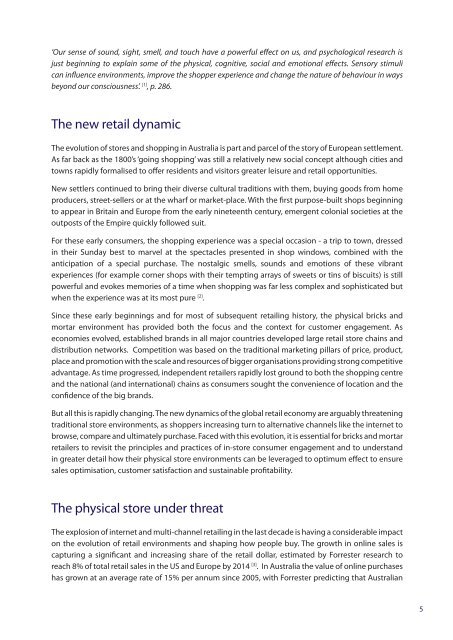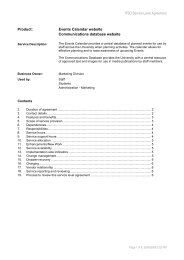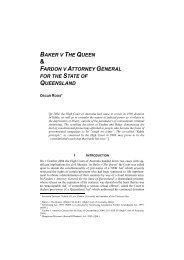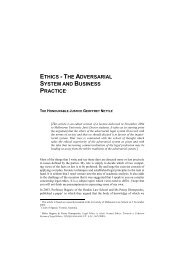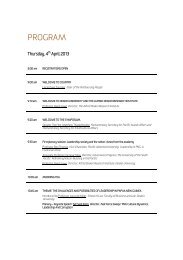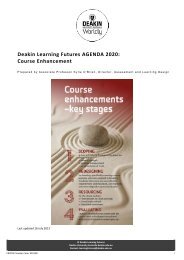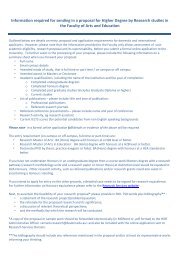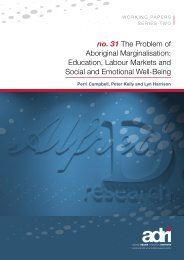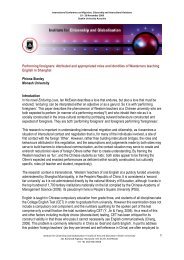Store sense: Reclaiming the four walls with - Deakin University
Store sense: Reclaiming the four walls with - Deakin University
Store sense: Reclaiming the four walls with - Deakin University
You also want an ePaper? Increase the reach of your titles
YUMPU automatically turns print PDFs into web optimized ePapers that Google loves.
‘Our <strong>sense</strong> of sound, sight, smell, and touch have a powerful effect on us, and psychological research is<br />
just beginning to explain some of <strong>the</strong> physical, cognitive, social and emotional effects. Sensory stimuli<br />
can influence environments, improve <strong>the</strong> shopper experience and change <strong>the</strong> nature of behaviour in ways<br />
beyond our consciousness’. [1] , p. 286.<br />
The new retail dynamic<br />
The evolution of stores and shopping in Australia is part and parcel of <strong>the</strong> story of European settlement.<br />
As far back as <strong>the</strong> 1800’s ‘going shopping’ was still a relatively new social concept although cities and<br />
towns rapidly formalised to offer residents and visitors greater leisure and retail opportunities.<br />
New settlers continued to bring <strong>the</strong>ir diverse cultural traditions <strong>with</strong> <strong>the</strong>m, buying goods from home<br />
producers, street-sellers or at <strong>the</strong> wharf or market-place. With <strong>the</strong> first purpose-built shops beginning<br />
to appear in Britain and Europe from <strong>the</strong> early nineteenth century, emergent colonial societies at <strong>the</strong><br />
outposts of <strong>the</strong> Empire quickly followed suit.<br />
For <strong>the</strong>se early consumers, <strong>the</strong> shopping experience was a special occasion - a trip to town, dressed<br />
in <strong>the</strong>ir Sunday best to marvel at <strong>the</strong> spectacles presented in shop windows, combined <strong>with</strong> <strong>the</strong><br />
anticipation of a special purchase. The nostalgic smells, sounds and emotions of <strong>the</strong>se vibrant<br />
experiences (for example corner shops <strong>with</strong> <strong>the</strong>ir tempting arrays of sweets or tins of biscuits) is still<br />
powerful and evokes memories of a time when shopping was far less complex and sophisticated but<br />
when <strong>the</strong> experience was at its most pure [2] .<br />
Since <strong>the</strong>se early beginnings and for most of subsequent retailing history, <strong>the</strong> physical bricks and<br />
mortar environment has provided both <strong>the</strong> focus and <strong>the</strong> context for customer engagement. As<br />
economies evolved, established brands in all major countries developed large retail store chains and<br />
distribution networks. Competition was based on <strong>the</strong> traditional marketing pillars of price, product,<br />
place and promotion <strong>with</strong> <strong>the</strong> scale and resources of bigger organisations providing strong competitive<br />
advantage. As time progressed, independent retailers rapidly lost ground to both <strong>the</strong> shopping centre<br />
and <strong>the</strong> national (and international) chains as consumers sought <strong>the</strong> convenience of location and <strong>the</strong><br />
confidence of <strong>the</strong> big brands.<br />
But all this is rapidly changing. The new dynamics of <strong>the</strong> global retail economy are arguably threatening<br />
traditional store environments, as shoppers increasing turn to alternative channels like <strong>the</strong> internet to<br />
browse, compare and ultimately purchase. Faced <strong>with</strong> this evolution, it is essential for bricks and mortar<br />
retailers to revisit <strong>the</strong> principles and practices of in-store consumer engagement and to understand<br />
in greater detail how <strong>the</strong>ir physical store environments can be leveraged to optimum effect to ensure<br />
sales optimisation, customer satisfaction and sustainable profitability.<br />
The physical store under threat<br />
The explosion of internet and multi-channel retailing in <strong>the</strong> last decade is having a considerable impact<br />
on <strong>the</strong> evolution of retail environments and shaping how people buy. The growth in online sales is<br />
capturing a significant and increasing share of <strong>the</strong> retail dollar, estimated by Forrester research to<br />
reach 8% of total retail sales in <strong>the</strong> US and Europe by 2014 [3] . In Australia <strong>the</strong> value of online purchases<br />
has grown at an average rate of 15% per annum since 2005, <strong>with</strong> Forrester predicting that Australian<br />
5


